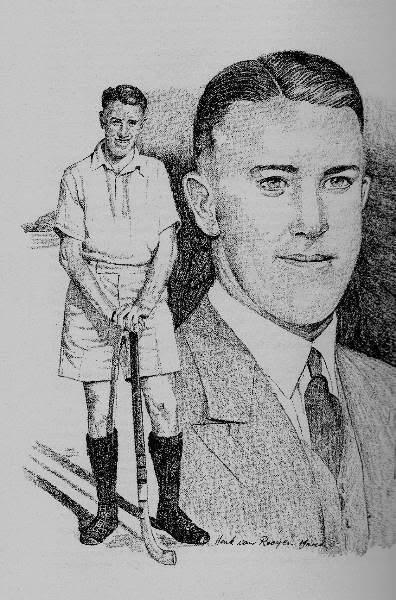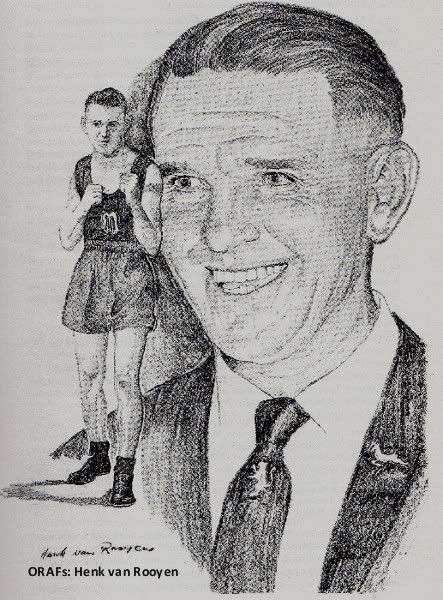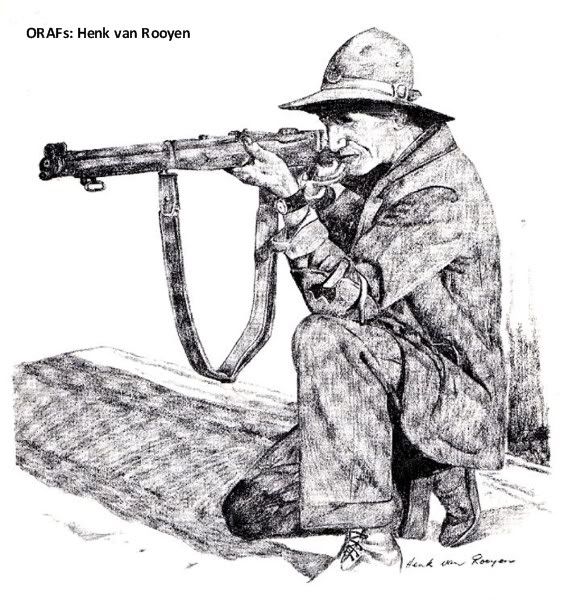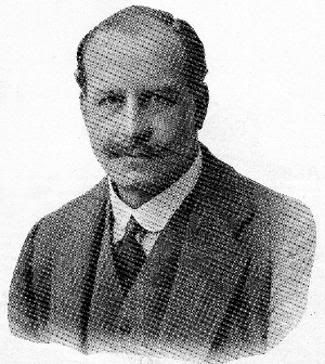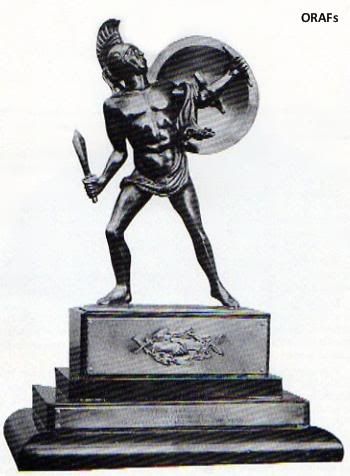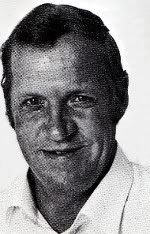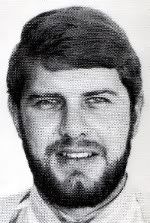It was as a retiring sixteen-year-old Bulawayo schoolboy that Percy Mansell made his first-class cricket debut for Rhodesia against Transvaal at Johannesburg in 1936. On that occasion he took the wickets of Tony Harris and N. Cook and with two splendid slip catches commenced his career as a specialist in a position where he subsequently established a reputation as one of the world's best.
When the bespectacled Mansell. at the age of fifty-nine still as humble and quiet as ever steppe down as a senior selector at the end of the 1978-79 season, he had served his country as player and administrator for forty-three years — an outstanding record of loyalty. And he continues to serve on the new Zimbabwe Cricket Union Board of Control.
But Mansell will be remembered for far greater things than his unswerving loyalty, for in a country which produced such players as Bland, Lewis. Partridge, Du Preez, Pithey, Lawrence and Tomlinson he will go down in the record books, and in the memories of those who watched him in his hey-day, as the greatest Rhodesian cricketer of all.
Percy Neville Frank Mansell was born at St. George's, Shropshire, a small village near Shrewsbury in England, on 16 March 1920. He came to the then Rhodesia (now Zimbabwe) when just three months and three days old and has remained in Bulawayo since. He attended Milton Junior School and played for the school cricket team in 1931. At high school he was a regular member of Milton 1 st XI from 1934-36 and in his last year at school represented Matabeleland and then Rhodesia against Transvaal in December.
He was also a junior tennis player of note, but decided to concentrate on cricket once he came under the fatherly and experienced eye of Gerald Ledeboer, the man who had coached such players as Jock Thompson, Jack Hayward, Arnold Hyde and Jack Charsley. It was Milton that also produced such noted players as Harry? Evans and Cecil Harris and, much later, Bland.
It was evident from an early age that Mansell was a player of outstanding all- round merit and his fluent strokes and puzzling leg breaks were the envy of all.
When Walter Hammond's MCC team arrived in Bulawayo in 1939 it was natural that young Mansell would be chosen to oppose them and. a few weeks before his nineteenth birthday, he made an impressive 62 for Rhodesia. The War years and ill health curtailed Mansell's career until early 1946 when he scored 37 in a friendly against Transvaal. It was in March 1947, in another friendly against Transvaal at Salisbury, that he scored his maiden first-class century, a brilliant 111 not out. He followed with 65 in the second innings.
Until 1960, when he retired from big-time cricket at the age of forty, 'perennial' Percy — always the quiet gentleman of cricket — dominated Rhodesian cricket as supreme all-rounder. And none finer has emerged since. An accountant with the Railways at Bulawayo all his working life, and a confirmed bachelor, Mansell was to prove his cricketing quality when he went on three overseas tours w\th the Springboks — to England (1951 and 1955) and to Australia and New Zealand (1952-53). One of South Africa's five Cricketers of the Year in 1955 he ultimately played in 13 Tests, scoring 355 runs in 22 innings with a top score of 90 when he just missed the distinction of becoming the first Springbok to score a century in a maiden Test innings. He also took 11 Test wickets for 736 runs at an average of 66,91 and held 15 catches. With hands uncommonly large and reactions swift and fluent, few catches escaped him in the slips. One can recall many brilliant catches in his career, an important skill, part of the make-up of the complete all-rounder. For his services to cricket Mansell was awarded the MBE in the Queen's New Year's honours list of 1962.
Following the visit of Hammond's MCC team, Mansell gained a wealth of experience in top-flight company after the War when he played for Rhodesia — though with limited success — against the 1948-49 MCC tourists captained by George Mann. Both matches were rain affected and were drawn. At Bulawayo, Rhodesia made 174 and 166 and the MCC 193 (Compton 60) and 117-2. The Salisbury scores in February 1949 were: MCC 228 (Hutton 79; Compton 34; Martin 6-49); Rhodesia 61 (Martin 27 n.o.; Bedser 6-17; Gladwin 4-37) and 191-5. The tourists also included such famous names as Washbrook, Tremlett, Palmer and Mann, while Bob Newson and Hugh Tayfield were then playing for Rhodesia.
The following season (1949-50) Lindsay Hassett's Australians toured Southern Africa and beat Rhodesia by an innings and 161 runs at Bulawayo's Queens Ground. Rhodesia's batsmen could not stand up to the attack of Lindwall, Walker and Johnson, but Mansell made his international reputation as a leg spinner, taking 6-89 in 14,7 overs and dismissing Morris, Moroney, Loxton, Langley, Lindwall and Noble! Scores: Australia 398 (Morris 104; Moroney 104; Mansell 6-89); Rhodesia 166 and 71.
In 1950-51 Mansell captained Rhodesia for one season, playing two fine innings of 46 and 59 against powerful Transvaal that placed him in a class of his own and brought attention from the Springbok selectors. Transvaal won that Salisbury Currie Cup game by an innings and 141 runs, Eric Rowan hitting 178. Among Mansell's other performances during that season were 65 not out against North Eastern Transvaal, 7-78 against Western Province and 4-86 against Griqualand West. He finished with 345 runs and 27 wickets in five Currie Cup matches and was invited to the final Springbok trial at Kingsmead, Durban from 15-19 February 1951. This was a twelve-a-side affair in which Mansell had an innings analysis of 5-101 in 29,5 overs to impress the five selectors, Arthur Coy, Syd Pegler, Tup Holmes, Carle Schwabe and Frank Lambert.
The thirty-year-old Mansell was that night named in Dudley Nourse's South African team to tour England (1951) becoming Rhodesia's second Springbok cricketer after Denis Tomlinson, who had earned his colours sixteen years previously. Mansell was a new cap in the side along with Jackie McGlew, Roy McLean, Geoff Chubb, Russell Endean, Clive van Ryneveldt and John Waite. Other players chosen were Dudley Nourse, Eric Rowan, Jack Cheetham, Geoff Fullerton,Tufty Mann, Cuan McCarthy, Michael Melle and Athol Rowan.
Mansell played 20 first-class matches on tour, batting 27 times to compile 504 runs at an average of 21,91 with three half-centuries. He also claimed 29 wickets at 36,55 apiece, his best being 5-37 in 26 overs against Glamorgan. The statistics also show that Mansell played in two Tests, bowling only four overs without a wicket, but scoring a 90 to average 32,66 for third in the averages. But they do not reveal the drama behind the Bulawayo man's Test debut, when he came in for Fullerton in the fourth international at Headingley, Leeds.Batting gracefully at number seven he attacked the bowling to reach his half- century in 75 minutes. Everyone shared his disappointment when he fell to a catch by Tattersall just ten short of an historic century. He was at the crease for 2¾ hours and hit 17 fours facing the bowling of Bedser, Bailey, Brown and Tattersall. Mansell batted along with Eric Rowan in this innings, the famous Springbok scoring 236 and occupying the crease for a mammoth 575 minutes — the fourth longest Test innings on record at that time. South Africa scored 538 and England reached 500, with centuries from Hutton and May, for the match to be drawn.
But there was little distinction for Mansell in the fifth Test at The Oval. He scored 8 and 0 and did not bowl as the Springboks succumbed by four wickets.
The 1951-52 home season again saw Mansell in outstanding all-round form, averaging 48,5 with the bat with a top score of 94 not out and taking 49 wickets at an average of 16,37. On six occasions he claimed five wickets in an innings, operating as an opening bowler against Border in East London to take 6-91 and 7- 114. His best was 7-71 against North Eastern Transvaal at Pretoria.
After attending a final trial at Newlands, Mansell was named in Jack Cheetham's Springbok team to tour Australasia in 1952-53. That team was: Jack Cheetham, Jackie McGlew, Russell Endean, Eddie Fuller, Ken Funston, Gerald Innes, Hedley Keith, Eric Norton, Percy Mansell, Roy McLean, Michael Melle, Anton Murray, Hugh Tayfield, John Waite and John Watkins.
On this heroic tour, Mansell played in all five Tests against Australia and in the two against New Zealand. In nine innings against the Aussies he scored 141 runs with one half-century and an average of 23,50. He also took nine wickets at 56,55. In other first-class matches Mansell scored 352 runs, putting on 108 with McGlew in 87 minutes against West Australia. His best bowling was 6-53 in 14,3 overs against Victoria, when he also held four great catches.
It is worth recounting that drama-filled series which the Springboks, through sheer tenacity and superb teamwork, drew 2-2.
Australia won the first Test at Brisbane by 96 runs, Neil Harvey's classical 109 being the outstanding performance. Mansell, who scored 31, was one of only three Springboks to reach 30 in the first innings. At Melbourne in the second Test, South Africa humbled the might of Australia by 82 runs with 2½ hours to spare, Mansell taking 3-58 in 19 overs thus making a vital contribution — his victims being McDonald, Hassett and Hole. Tayfield, with 6-84 and 7-81, was man-of-the-match.
The classy Harvey scored 190 out of 443 while Lindwall and Miller took eight and five wickets respectively as the Aussies stormed to victory by an innings and 38 runs in the third Test at Sydney. The fourth Test at Adelaide was drawn, Hassett scoring 163 before being dismissed by Mansell. McDonald made 154 and Harvey 84 in an Australian total of 530. Harvey's second innings contribution was 116.
And so to that exciting fifth Test at Melbourne, won by Cheetham's side by six wickets to square the series to become only the second team in history to win after facing a first innings score of over 500. The rampant Harvey got 205 of Australia's 520, South Africa replying with 435 (Watkins 92; McLean 81; Cheetham 66; Mansell 52). The Aussies reached 209 in their second innings (Fuller 5-56) and, led by Roy McLean (76 not out) in Jessopian style, South Africa won at 297-4. In this Test Mansell played a vital role in staying with Cheetham for a seventh wicket partnership of 111. occupying the crease for 2Vi hours.
Summing up after the tour, commentator Charles Fortune wrote: "Mansell was always calm and passive to the outward eye. It is not bowling but batsmanship that brings out the power that lies in Mansell's frame. He delights in the desperate hour. My vivid memories of Mansell slip catches at Brisbane and Perth, battering Miller and baffling Australia's batsmen when alone with Tayfield he held the bowling breach at Melbourne."
Mansell did not gain Springbok selection for the home series against Geoff Rabone's New Zealanders in 1953-54 but was again chosen to tour England in 1955 with Cheetham's team. England won an absorbing and pulsating series 3-2, but the Springboks did win 13 of their other 23 first-class games, losing only one. Though not scoring a first-class century, Mansell did score 148 against Durham at Sunderland, batting for only 122 minutes. Against Leicester he took 6-52 in 23 overs of leg-spin. And of Mansell's fielding, author Gordon Ross wrote after the tour: "As a slip fielder he surely has no peer. He took some fantastic catches on this tour."
It was on this tour that swashbuckling Paul Winslow scored 40 off eight deliveries from Jack Ikin against Lancashire at Old Trafford. Then at the same venue Winslow reached his maiden first-class century with a gigantic six in the third Test after batting for 170 minutes. Mansell's four Test appearances were not happy ones — his top score was only 16, he totalled only 45 and he took but one wicket.
The season 1955-56 was a fine one for Rhodesia. The team played positive, winning cricket and achieved promotion with six outright victories in the B Section — the first occasion this had been achieved in the Currie Cup competition. It is fitting to name the players, who were Lewis (captain), O'Connell-Jones, Baldwin, Duckworth, Mansell, Davies, Kemp, Coventry, Arnott, Lawrence, Partridge and Slaven.Mansell topped both the batting and bowling averages for the entire B Section, scoring 393 runs in six innings (top score 154 against Kimberley and also 148 against Griqualand West at Bulawayo) for an average of 65,50. He also took 36 wickets at 14,38. David Lewis, Dennis O'Connell-Jones and Marshall Davies also each scored two centuries in the season, while Mansell and Davies put on 203 for the fifth wicket against Griqualand West at Bulawayo — still a national record for that wicket.
November 1956 provided Rhodesian cricket with a great treat with the arrival of the MCC, captained by Peter May, for matches at Bulawayo and Salisbury. At Queens Ground Mansell gained the distinction of becoming the first batsman to take a half-century off the tourists — this against the formidable attack of Tyson, Loader, Bailie, Wardle and Lock. After Rhodesia had made 192, the MCC gave a fine exhibition by reaching 407-7 (Richardson 100, May 124). Rhodesia batted again on the last day and at lunch had reached 86-2. Then came a torrential storm and not until four o'clock did play resume. MCC, thanks to Lock, made full use of the rain-affected pitch and the innings closed at 129, Rhodesia being the losers by an innings and 86 runs.
The beautiful Salisbury Sports Club grounds provided the setting for the second match, attended by a total of 26 000 spectators — the biggest ever for a cricket match in this country. On a perfect pitch Bailey and May revealed their class with a fourth wicket partnership of 301, May batting for 265 minutes to score his majestic 206. Rhodesia lost by an innings and 292 runs. Mansell also played for Rhodesia against Ian Craig's 1957-58 Australians at both Salisbury and Bulawayo, top scoring with 50 not out in the second match which Rhodesia lost by 10 wickets.
In 1958-59 it was back to Currie Cup cricket and the big test for newly promoted Rhodesia, who did superbly to finish joint second in the A Section with Natal and Western Province. Transvaal were just three points ahead. This was an extremely powerful Rhodesian side, eight men having played for South Africa. They were Tony Pithey, Chris Duckworth, Colin Bland, Percy Mansell, Paul Winslow, Godfrey Lawrence, Joe Partridge and David Pithey. Don Arnott had been chosen as reserve Test wicket-keeper while Harold Paton received a trial.Mansell ended his distinguished career with a flourish, playing a leading part in Rhodesia's thrilling two-run victory against Stuart Surridge's Surrey team in October 1959 at Salisbury, taking 13-120 in the match.
Let David Lewis, Rhodesia's greatest captain, sum up: "A great debt is owed to Percy Mansell for his outstanding and unselfish all-round contributions to the Rhodesian cricket scene over a quarter of a century of playing. There cannot have been a greater playing contribution by any one person."
- BYROM.
To view the Blog Home Page
- Please Click Here.
(Please
visit our previous posts and archives)Labels: Percy Neville Frank Mansell


